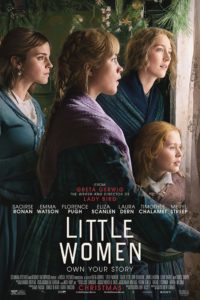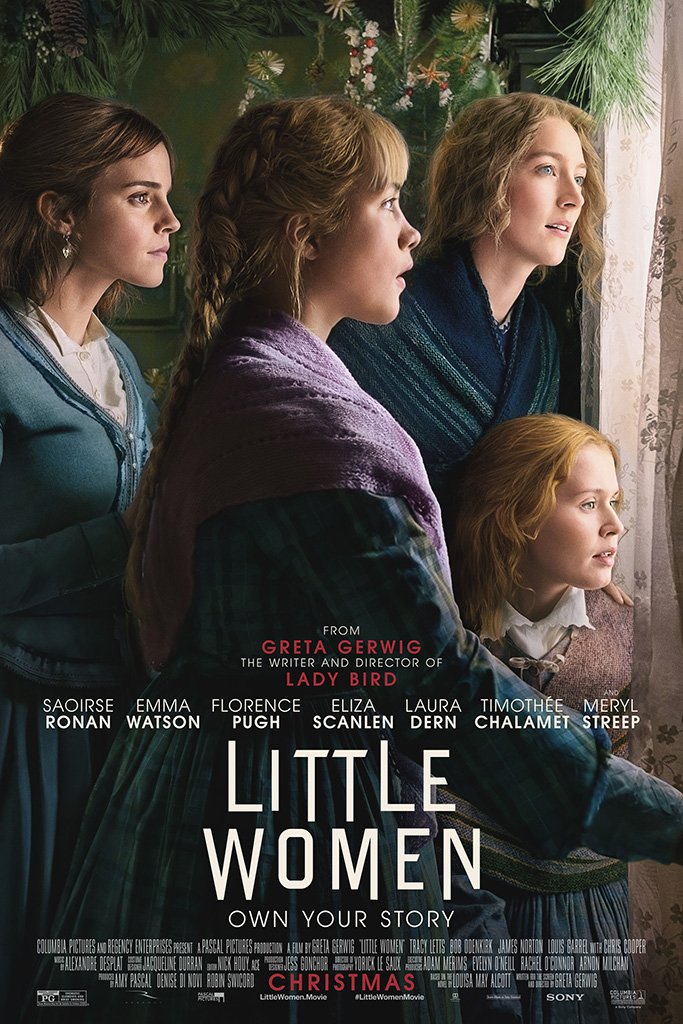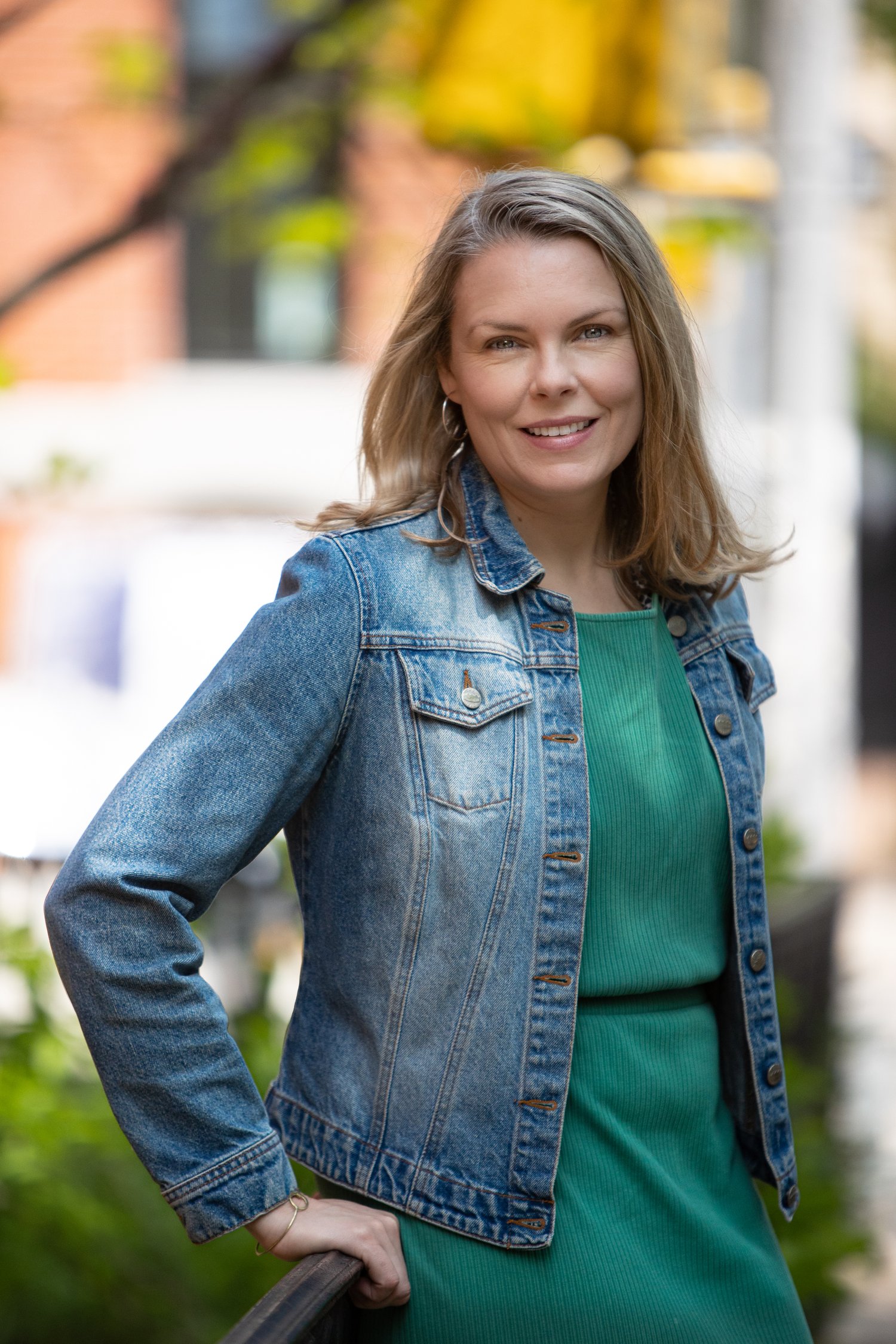
Movie directed by GRETA GERWIG
Review by HANNAH GERSEN
I have friends who cried their way through Greta Gerwig’s Little Women, and I expected that I would, too, but I spent much of my first viewing in a state of mild agitation. I had re-read the novel a few days before seeing the film, and was distracted as I tried to figure out the mechanics of Gerwig’s complex temporal structure. Little Women was originally published as two books: Little Women and Good Wives, and Gerwig braids together these two volumes, going back and forth between past and present. As with Gerwig’s debut feature Lady Bird, the pace is galloping. Not only are there two separate timelines, Gerwig cuts rapidly between characters and locations within each timeline.
My second viewing was much more relaxed, and if I can make any recommendation, it would be to wait until after you’ve seen the movie to reread the novel. (You may also want to see the movie before reading this review, which discusses the ending in detail.) Gerwig’s version assumes that you have read the book, but not recently. It’s a wonderfully literary adaptation that honors the experience of reading a book as a child and revisiting it with an adult’s analytical eye. I went into Gerwig’s Little Women expecting only the childlike pleasures of reading: the pictures that rise off the page. I got that, but I also got a critical essay about how Louisa May Alcott drew from her own life to create Little Women, and an explicit feminist argument about the conditions required for a woman to make art.
The first volume of Little Women is the most familiar, and takes place mostly in the March girls’ home of Concord, Massachusetts, as it follows Meg, Jo, Beth, and Amy through girlhood. It concludes with Meg’s engagement, and includes many of the book’s best-remembered plot elements: Jo accidentally burning Meg’s hair with a curling iron; Amy destroying Jo’s precious manuscript; Beth contracting and nearly dying from scarlet fever; and of course, the close friendship between Jo and Laurie, the wealthy boy next door. I must admit that I was a little bored when I re-read the first volume. Its pacing is extremely slow and it has an episodic structure reminiscent of network television sitcoms, with each chapter focusing on one character and concluding with a moral, usually delivered by Marmee.
In the second volume, the story moves more quickly as the girls make their way in the wider world. Except for Beth, who is still sickly, the girls have left home: Jo works as a tutor and writer in New York City, Meg is a new mother to twins, and Amy is studying abroad. I loved reading these chapters, with their straightforward descriptions of young adulthood, and found many passages relevant to my own experience. Here’s Jo’s reaction to getting her first novel published:
Well, it was printed, and she got three hundred dollars for it; likewise plenty of praise and blame, both so much greater than she expected that she was thrown into a state of bewilderment, from which she took some time to recover.
Meg, in the first year of motherhood:
She was nervous and worn out with watching and worry, and in that unreasonable frame of mind which the best of mothers occasionally experience when domestic cares oppress them, want of exercise robs them of cheerfulness, and too much devotion to that idol of American women–the teapot–makes them feel as if the were all nerve and no muscle.
And Amy, after a few months in Europe:
Always mature for her age, she had gained a certain aplomb in both carriage and conversation which made her seem more of a woman of the world than she was; but her old petulance now and then showed itself, her strong will held its own, and her native frankness was unspoiled by foreign polish.
Gerwig’s innovation is to take these grown Little Women, each on their individual life paths, as the jumping off point for her movie, and then to flash back to the girls’ shared childhood. The film operates on two timelines: one that takes place after the Civil War is over, and kicks off with Jo heading home to care for sickly Beth after a long sojourn in New York, and after she has rejected Laurie’s marriage proposal. A past-tense timeline begins seven years earlier, during the Civil War, when the March girls’ father is away at war, and when Jo and Laurie first become friends. Both timelines move forward in time, and eventually converge in the third act, after Beth’s death. The final act is concerned with Jo’s fate in the aftermath.
Gerwig’s rewrite upends the suspense of the original novel, because two of the book’s biggest plot points—that Jo rejects Laurie, and that Beth is deathly ill—are revealed within the first five minutes, but Little Women was never really about its sensational plotting. Its true gift to readers is that it gives four detailed portraits of girls who each approach life in different ways, owing to their differing temperaments, ambitions, and circumstances. It speaks frankly about childcare, money, and housework, treating them as serious subjects, worthy of attention. Gerwig’s film does the same, especially with regard to money. There are numerous conversations about finances, whether it’s Aunt March informing Amy that she will have to marry rich, Meg trying to justify the purchase of an expensive fabric, or in the very first scene, Jo negotiating the sale of her first short story. In one startling exchange, that is partly lifted from Alcott’s novel, Amy tells Laurie that she cannot afford to be romantic about love, because her family is poor. She informs him that she’s not the shallow person he thinks she is—she’s just a clear-eyed woman, with limited options. The Amy that emerges from Gerwig’s version has a feminist consciousness; she’s the one who advises Jo to write about domestic life, because to do so would be to “confer importance.”
This strain of feminism is not Gerwig’s modern imposition. It arises from the original text at various points, sometimes rather bitterly. I was struck by this passage, which comes after Amy tells Laurie he’d be happier if he stopped gallivanting around Europe and took a job with his grandfather:
Amy’s lecture did Laurie good, though, of course, he did not own it till long afterward; men seldom do—for when women are the advisers, the lords of creation don’t take the advice till they have persuaded themselves that it is just what they intended to do; then they act upon it, and, if it succeeds, they give the weaker half the credit of it; if it fails, they generously give her the whole.
Gerwig’s most important feminist excavation concerns the ending. The novel ends with Jo marrying Professor Bhaer, a significantly older man who she meets in a boarding house in New York. After marriage, she gives up writing professionally to co-found a school with the professor and teach full-time. Alcott tells us, somewhat unconvincingly, “Jo was a very happy woman there, in spite of hard work, much anxiety, and a perpetual racket.” Alcott also notes that Jo continues to make up stories, but only for her students:
She found the applause of her boys more satisfying than any praise of the world—for now she told no stories except to her flock of enthusiastic believers and admirers.
As a girl, I didn’t like this ending, in part because Professor Bhaer seemed like such a bore. But maybe I also didn’t believe it because, forty pages earlier, there is an intriguing section that seems to resolve Jo’s storyline in a different way. It comes after Beth’s death, when Jo is grieving, lonely and unhappy living at home. Meg tries to convince her to get married or else devote herself to caring for their parents into their old age, but neither of these options appeal to Jo. Alcott then makes this strange remark:
Now, if she had been the heroine of a moral storybook, she ought at this point of her life to have become quite saintly, renounced the world, and gone about doing good in a mortified bonnet, with tracts in her pocket. But you see Jo wasn’t a heroine; she was only a struggling human girl . . . what could be harder for a restless, ambitious girl, than to give up her own hopes, plans and desires, and cheerfully live for others?
What follows is a brief section in which Jo takes up writing again, and begins to publish work that is close to her heart, and perhaps autobiographical. This work finds an enthusiastic audience, with editors clamoring for more. It seems like a new beginning for Jo! But Alcott abruptly drops this storyline to attend to Amy’s marriage to Laurie—it’s as if she remembered, suddenly, that she had to tie up her marriage plot, as convention required.
I don’t know if Gerwig highlighted the same passage, but she radically changes the end of her Little Women by structuring the final act of her screenplay around Jo’s literary ambitions. After an anguished conversation with Marmee, in which Jo says, “if I were a girl in a book this would all be so easy,” we see Jo find inspiration for new writing in an autobiographical story that she wrote for Beth. We watch as Jo works feverishly on a new manuscript only to have the opening chapters dismissed as “boring” by her publisher, Mr. Dashwood. Jo then receives an unexpected visit from her old friend Professor Bhaer, and it seems as if she is about to declare her love for him. But that storyline is complicated when Dashwood, thanks to his daughters’ insistence, has a change of heart and wants to read the rest of Jo’s book.
Gerwig then stages a conversation between Jo and Dashwood that, at least according to the introduction of my edition of Little Women, is similar to the discussions Alcott herself underwent when publishing Little Women. Dashwood expresses disappointment that the heroine of her novel—a character we can safely assume is someone like Jo—isn’t marrying Laurie. As a compromise, Jo suggests a romantic ending for Jo with a proposal from Professor Bhaer. Gerwig then cuts back to Jo’s visit from Bhaer to show Jo running to meet Bhaer at the train station. She shoots it in classic Hollywood rom-com style, with the two lovers kissing in the rain beneath an umbrella and the camera panning around them. The scene is cut short by the voice of Jo’s publisher, saying how much he loves it. He and Jo then negotiate the terms of her book contract. It’s a little confusing, and some viewers might find it too clever by half, but for me, it was the ending that provided the emotional punch I’d initially expected. I was most moved by an image that Gerwig discloses in the final passages, when Jo receives a finished copy of Little Women: as Jo takes the book into her hands, we see flashbacks to the March girls as very little children, under the age of ten, playing dress-up and lost in their imaginary worlds.
I worry that this review, which focuses mainly on literary parallels, will make Gerwig’s adaptation seem overly analytical. Let me assure readers and viewer alike that in addition to being deeply attentive to Little Women and the story behind its creation, Gerwig’s adaptation is also visually and sonically rich, with detailed and character-driven costumes by Jacqueline Durran, numerous dance sequences, a melodic score by Alexandre Desplat that helps to weave the timelines together, and overlapping dialogue that creates its own kind of music. Gerwig also plucked the most visually appealing locations from the book, including a trip to the New England seaside that is only briefly mentioned in Alcott’s novel. Gerwig takes that suggestion, as well as a singular metaphor from Beth’s dialogue, to create a haunting portrait of the two sisters sitting together on a windy beach and looking out at the ocean after everyone else has gone home. Instead of framing the girls in silhouette, with their back to the camera and the ocean in the background, the camera faces the girls. It’s almost as if we are seeing them from the point of view of the tide, which will pull Beth in and leave Jo behind. The first time I saw it, I was struck by its beauty; the second time, by its incredible sorrow.
Sometimes a movie can spoil a book by painting over a scene that you’ve imagined, putting an actor’s face or a famous location over your more deeply personal, imagined ones. The joy of this latest adaption is that it gives you scenes, ideas, and arguments that lurk beneath the surface of the text, waiting for a perceptive reader to draw them out.
Hannah Gersen is a fiction writer and staff writer at The Millions. Her debut novel, Home Field, was released in 2016. She writes about movies on a semi-regular basis on her blog, Thelma and Alice.




